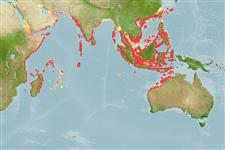Actinopterygii (ray-finned fishes) >
Clupeiformes (Herrings) >
Clupeidae (Herrings, shads, sardines, menhadens) > Dorosomatinae
Etymology: Amblygaster: Greek, amblys = darkness + Greek, gaster = stomach (Ref. 45335).
Environment / Climate / Range
Ecology
Marine; pelagic-neritic; depth range 0 - 50 m (Ref. 188). Tropical, preferred ?; 30°N - 23°S, 39°E - 129°E (Ref. 188)
Indo-West Pacific: coasts of Africa eastward to Okinawa, Japan; south to Western Australia.
Size / Weight / Age
Maturity: Lm ? range ? - ? cm
Max length : 23.0 cm SL male/unsexed; (Ref. 188); common length : 18.0 cm SL male/unsexed; (Ref. 188)
Dorsal
spines
(total): 0;
Dorsal
soft rays
(total): 13-21;
Anal
spines: 0;
Anal
soft rays: 12 - 23. Body moderately slender, belly rather rounded, scutes not prominent. Distinguished from A. sirm by the absence of spots along the flank (gold in life, black on preservation) and fewer lower gill rakers. Closely resembles A. clupeoides, which has fewer lower gill rakers.
A schooling species occurring in coastal waters (Ref. 188, 75154).
Life cycle and mating behavior
Maturity | Reproduction | Spawning | Eggs | Fecundity | Larvae
Spawn in school (Ref. 205).
Whitehead, P.J.P., 1985. FAO Species Catalogue. Vol. 7. Clupeoid fishes of the world (suborder Clupeioidei). An annotated and illustrated catalogue of the herrings, sardines, pilchards, sprats, shads, anchovies and wolf-herrings. FAO Fish. Synop. 125(7/1):1-303. Rome: FAO. (Ref. 188)
IUCN Red List Status (Ref. 115185)
CITES (Ref. 94142)
Not Evaluated
Threat to humans
Harmless
Human uses
Fisheries: subsistence fisheries
More information
ReferencesAquacultureAquaculture profileStrainsGeneticsAllele frequenciesHeritabilityDiseasesProcessingMass conversion
Tools
Special reports
Download XML
Internet sources
Estimates of some properties based on models
Phylogenetic diversity index (Ref.
82805): PD
50 = 0.6250 [Uniqueness, from 0.5 = low to 2.0 = high].
Trophic Level (Ref.
69278): 3.4 ±0.45 se; Based on food items.
Resilience (Ref.
69278): High, minimum population doubling time less than 15 months (Assuming Fec > 10,000).
Vulnerability (Ref.
59153): Low to moderate vulnerability (26 of 100) .
